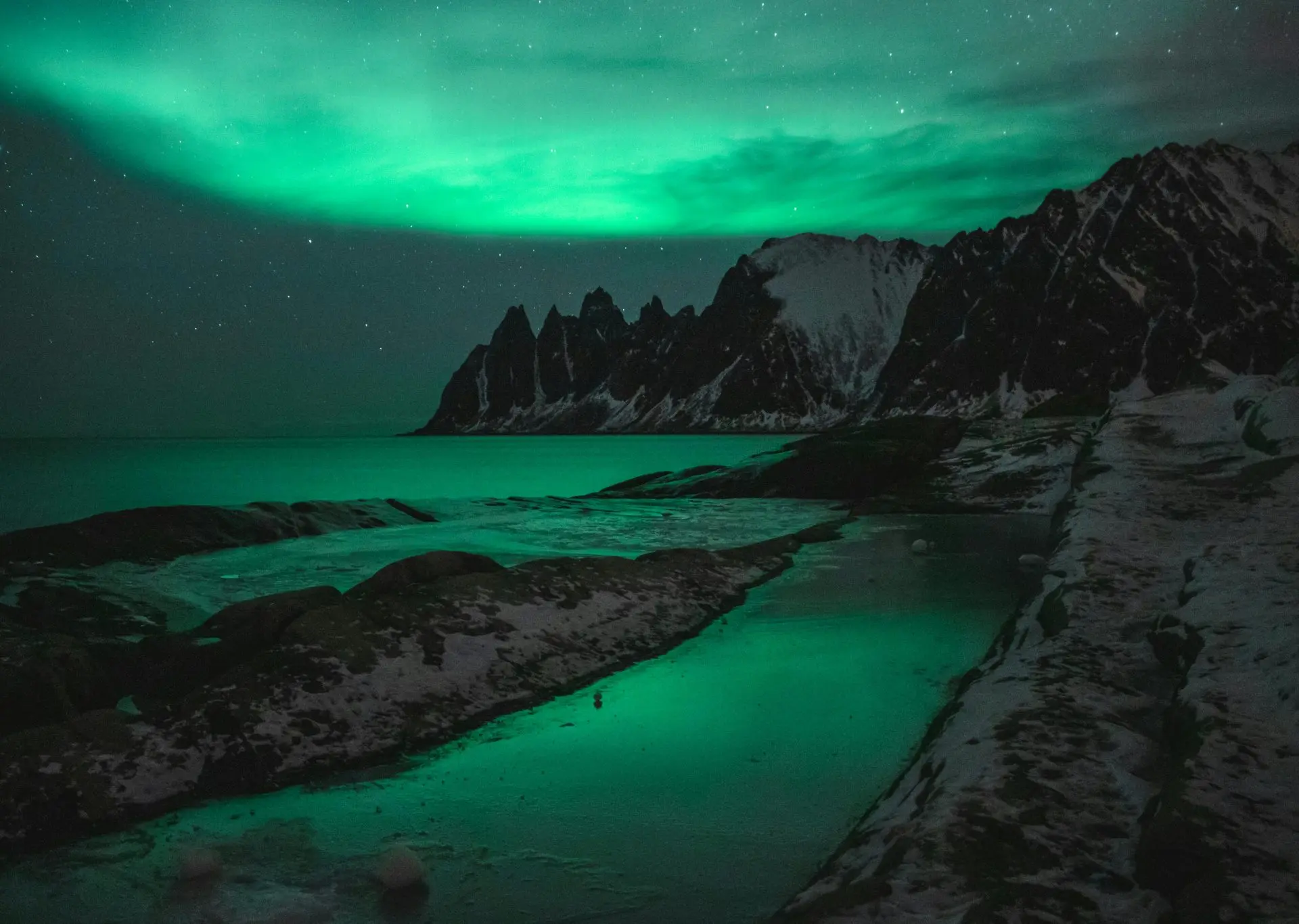Why Did the Vikings Disappear from Greenland?

Looking for more amazing products? Check out our online store and explore our collection here! Happy shopping!
Before diving in, please note: This post is for informational purposes only. If you’d like to know more about how we approach topics, feel free to check out our friendly Disclaimer Page.
Hey there, amazing readers! 
We’re committed to delivering quality posts, and your support (even just sticking around despite the ads) means everything to us. So, bear with us, and thanks for helping us keep the good vibes rolling. Now, on to the fun stuff!
TRANSLATE BUTTON AT THE END OF THE ARTICLE
A Quick Overview
The Vikings, those daring explorers and warriors from Scandinavia, made waves across Europe during the late eighth to early 11th centuries.
Their feats included everything from pillaging coastal villages to establishing settlements in far-flung places like Greenland.
But what happened to them in this icy expanse?
This article will delve into the reasons behind the mysterious disappearance of the Viking communities in Greenland.
So, grab a warm drink and join me on this historical journey!
The Viking Saga: A Brief Introduction to Their Journey
The Vikings were more than just fierce warriors; they were skilled seafarers and traders.
Originating from modern-day Norway, Sweden, and Denmark, their voyages took them across the North Atlantic, into the Mediterranean, and even as far as North America.
The Viking Age began around 793 AD, and these intrepid explorers were driven by a mix of trade, adventure, and, let’s be honest, a desire for plunder.
Their ships, known as longships, were marvels of engineering.
They were slim, swift, and could navigate both open seas and shallow rivers.
With these vessels, the Vikings reached places like England, Ireland, and even the bustling markets of Byzantium.
So, when news reached them about land beyond Iceland, they were bound to explore it.
Leif Erikson, the son of Erik the Red, is often credited with leading the first Viking expedition to Greenland around the year 1000.
Inspired by tales of a lush land, Erik the Red had previously settled in Greenland after being exiled from Iceland.
His discovery of this new territory was the start of a new chapter for the Vikings.
As they made their way to Greenland, they envisioned a fresh start—one filled with opportunity and adventure.
Little did they know that the challenges they would soon face would be monumental.
Settling in Greenland: A Bold Viking Adventure
Upon arriving in Greenland, the Vikings were greeted by a landscape that was both beautiful and harsh.
The land was green in summer but unforgiving in winter.
However, they were determined to make it their home.
Erik the Red named the region "Greenland" in an attempt to attract settlers, and it worked.
Soon, a community began to form.
The Vikings established two primary settlements: the Eastern Settlement, near present-day Qaqortoq, and the Western Settlement, closer to Nuuk.
These settlements thrived for several centuries, reaching their peak in the 12th century.
They constructed farms, churches, and even a few trading posts.
The Viking spirit was alive and well in this new land!
Life in these settlements was a mix of farming, hunting, and fishing.
The Vikings raised livestock, cultivated crops, and made use of the rich marine resources around them.
They even engaged in trade with the Inuit and other cultures, exchanging goods like walrus ivory and furs.
They built sturdy homes from turf and stone, which surprisingly withstood the cold climate.
Yet, this newfound life also required immense resilience.
The community had to adapt to the landscape and its seasonal changes.
They learned to navigate the hardships of living in Greenland.
Little by little, they made their mark on this challenging terrain.
Life in Greenland: How the Vikings Thrived
Life in Viking Greenland was, in many ways, a testament to human ingenuity.
The settlers utilized their skills honed in Norway and Iceland to build a sustainable lifestyle.
They relied heavily on both agriculture and animal husbandry.
Farming: The Vikings grew barley, rye, and oats.
They even cultivated crops like turnips and peas.
Farming was tough, but they used techniques like crop rotation to maximize yields.
Livestock: Goats, sheep, cows, and horses were vital for survival.
The Vikings’ expertise in animal husbandry ensured a steady supply of meat, milk, and wool.
Fishing: The ocean was rich with fish, especially cod, which became a crucial part of their diet.
They developed methods to dry fish for winter storage.
Hunting: The Vikings hunted seals, whales, and birds.
Their skills in hunting helped supplement their diet and provided materials for clothing and tools.
Trade: Viking Greenlandians established trade routes with Europe and even the Mediterranean.
They exchanged goods like walrus ivory, furs, and fish for artifacts from other cultures.
Community: With a population that peaked at around 5,000, these settlements fostered a strong sense of community.
They built churches and held gatherings, which helped maintain social cohesion.
Adaptability: The Vikings were quick to adapt to their surroundings.
They learned from the Inuit, picking up techniques for hunting and survival in harsh conditions.
Craftsmanship: Vikings were skilled artisans.
They crafted tools, clothing, and intricate jewelry, showcasing their creativity and resourcefulness.
Leadership: Strong leaders emerged in these settlements.
Chieftains often held power, helping to organize communal efforts and mediate conflicts.
Cultural Exchange: The interactions with the Inuit led to cultural exchanges, influencing their way of life.
They learned new methods for fishing and hunting.
Climate Change: The Uninvited Guest in Greenland
As with many historical tragedies, environmental factors played a significant role in the Vikings’ downfall in Greenland.
The Vikings initially thrived during a period known as the Medieval Warm Period, which lasted from around 950 to 1250 AD.
This era provided favorable conditions for agriculture and trade.
However, as the climate began to shift, the situation changed dramatically.
The onset of the Little Ice Age around the late 13th century brought cooler temperatures and harsher winters.
Colder Weather: The chilling climate made farming difficult.
Crops that had thrived during warmer years began to fail.
If you’ve ever tried to grow a garden in a harsh winter, you understand the challenge.
Shorter Growing Seasons: The growing seasons became significantly shorter.
This left the Vikings with little time to cultivate their essential crops, leading to food shortages.
Increased Storms: The North Atlantic experienced more storms, making fishing and trading increasingly dangerous.
Sea Ice: The expanding sea ice made it hard to travel and trade.
The once-busy trade routes became perilous, isolating Greenland from its European connections.
Dwindling Resources: With wildlife and fish stocks declining, survival became a daily battle.
The Vikings were used to a thriving environment, and nothing could prepare them for the sudden drop in resources.
The climate shift posed a significant crisis for the Viking settlers.
What had been a land of opportunity now felt like a trap.
Environmental Challenges: A Tougher Life Ahead
The changing environment didn’t just affect agriculture; it had a ripple effect on all aspects of Viking life in Greenland.
As resources became scarcer, the community faced a series of daunting challenges.
Food Scarcity: As crops failed, the population faced food shortages.
What do you do when the pantry runs dry?
For the Vikings, it meant increasing reliance on hunting and fishing, which were already under pressure.
Livestock Decline: Harsh winters often meant losses in livestock.
This impacted food production and made it hard to sustain the population.
Health Issues: Malnutrition led to health problems.
The lack of essential nutrients made the settlers more susceptible to diseases.
Social Strain: As resources dwindled, tensions within the community rose.
People began to compete for the limited food supplies, leading to conflicts.
Migration Pressures: Some Vikings tried to migrate back to Iceland or even Norway, but the daunting journey discouraged many.
The isolation amplified their plight.
Trade Disruption: The inability to trade effectively with Europe cut off crucial supplies.
Without new materials, the settlers struggled to maintain their crafts and tools.
Inuit Relations: As the Inuit population thrived in the changing environment, competition for resources grew.
The Vikings’ previous cordial relations faced strain.
Cultural Shifts: The community began to undergo cultural changes.
Traditions that were once vital started to fade as survival became the priority.
Spiritual Crisis: The hardships led some to question their beliefs.
When faced with such adversity, faith often wavers.
Environmental Degradation: Over time, the land itself began to suffer.
Unsustainable farming practices contributed to soil depletion, making recovery harder.
Trade Routes: The Lifeline of Viking Greenland
Trade was a crucial lifeline for the Viking settlements in Greenland.
Initially, they enjoyed rich and diverse trade networks that connected them to Europe, Iceland, and even North America.
However, as conditions changed, so did their ability to trade effectively.
Established Routes: The Vikings had well-established routes for exchanging goods.
They traded walrus ivory, furs, and fish for iron, timber, and other essentials.
Community Trade: Local markets thrived where Vikings exchanged homemade goods, fostering a spirit of cooperation.
European Connections: Trade with Europe was vital.
Vikings imported goods that were crucial for their survival; when the climate changed, many of these connections faltered.
Isolation Effects: As seas became ice-laden and treacherous, isolation took root.
Without new shipments of essentials, the settlers faced an uphill battle.
Declining Interest: As rumors of hardship spread in Europe, potential traders became wary.
Fewer ships made the journey to Greenland, doubting they’d find profitable ventures.
Dependency Issues: The settlers had become increasingly dependent on foreign imports, primarily due to their inability to sustain themselves during the cold periods.
Cultural Exchanges: Trade also facilitated cultural exchanges, bringing new ideas and technologies.
This aspect diminished as routes closed.
Resource Management: Over time, Vikings began to exhaust local resources, leading to a decline in tradeable goods.
They couldn’t offer what they once could.
Inuit Trade: Interaction with the Inuit could have opened new trade opportunities, but cultural differences and competition made that challenging.
Tragic Consequence: The decline in trade ultimately spelled doom for the communities.
Without the essential supplies they needed, survival became increasingly difficult.
Cultural Interactions: Vikings and the Inuit People
The arrival of the Vikings in Greenland brought them into contact with the indigenous Inuit peoples.
These two groups had vastly different ways of life, but their interactions shaped the Viking experience in Greenland.
Early Encounters: When the Vikings first arrived, they were intrigued by the Inuit way of life.
The Inuit were skilled hunters and had successfully adapted to the harsher conditions.
Exchange of Knowledge: The Vikings learned valuable survival skills from the Inuit.
Techniques for hunting and fishing became crucial for the settlers.
Trade Opportunities: The potential for trade existed between the two groups.
The Vikings had items like iron tools and textiles that the Inuit could find useful.
Cultural Curiosity: The Vikings displayed curiosity about the Inuit culture.
They observed their practices and sometimes adopted elements they deemed beneficial.
Competition for Resources: As resources dwindled, competition intensified.
The once cooperative relationship faced strains as both groups sought to survive.
Myth and Legend: Tales of the Inuit became part of Viking lore.
Their stories and experiences colored the Vikings’ understanding of the land.
Intermarriage Possibilities: Some historians suggest there may have been instances of intermarriage between the two groups, leading to a blending of cultures.
Conflict Encounters: Despite moments of curiosity, encounters sometimes resulted in conflict.
When resources became scarce, tensions could escalate quickly.
Cultural Symbolism: The Vikings’ interactions with the Inuit influenced their art and storytelling, enriching their cultural tapestry.
Lessons Learned: Both groups faced numerous hardships.
Their interactions highlighted the importance of adaptability and collaboration in challenging circumstances.
Resources Depleting: Struggles for Survival
As time marched on, the once-thriving Viking settlements faced increasing difficulties.
The depletion of resources became a critical issue that threatened their survival.
Overhunting: The Vikings relied on local wildlife for food.
Overhunting led to a significant decline in animal populations.
What happens when you take too much?
You’re left with little.
Farming Limitations: The colder climate reduced crop yields.
With shorter growing seasons, many settlements struggled to produce enough food.
Livestock Troubles: Harsh winters led to high livestock mortality rates.
Without animals, the community lost access to vital resources like milk and wool.
Fuel Shortages: The Vikings relied on wood for heating and cooking.
As forests were depleted, sourcing sufficient firewood became a challenge.
Fishing Pressures: Overfishing in nearby waters led to declining fish stocks.
The once-reliable food source started to dwindle.
Soil Degradation: Unsustainable farming practices caused soil erosion.
The land that once produced bountiful crops could no longer sustain them.
Water Scarcity: As the climate changed, so did water availability.
Some areas faced droughts, making access to fresh water more difficult.
Community Conflicts: With resources dwindling, tensions rose within communities.
People began to fight over what little remained.
Cultural Decline: As survival took precedence, cultural practices began to fade.
The rich traditions of the Vikings suffered under the weight of despair.
The Breaking Point: The culmination of these resource struggles marked a tipping point.
With little hope left, many Vikings considered abandoning their homes.
The Shift in Climate: A Cold Reality Sets In
The Little Ice Age had a profound impact on the Viking settlements in Greenland, marking a significant shift in their fortunes.
The cold reality of increased winter temperatures and shorter summers forced the Vikings to confront challenges they had never faced before.
Temperature Drops: As temperatures plummeted, farming became nearly impossible.
The once-favorable climate turned inhospitable.
Increased Sea Ice: More ice in the waters around Greenland made sea travel treacherous.
This isolation limited the community’s access to trade and resources.
Longer Winters: Winters became longer and harsher.
The Vikings, accustomed to the previous climate, found themselves unprepared for this sudden change.
Crops Failure: As crops failed to mature, the Vikings faced escalating food shortages.
What do you do when the land won’t yield?
Social Disintegration: The stress of survival began to erode community ties.
With resources dwindling, trust faltered, and conflicts emerged.
Reduced Birth Rates: The dire conditions led to a decline in birth rates.
Families struggled to maintain their numbers amid the growing hardships.
Migration Attempts: Faced with impossible living conditions, some Vikings attempted to leave Greenland, hoping for better opportunities elsewhere.
Cultural Loss: The climate crisis led to a profound cultural loss.
Many Viking traditions faded as survival took precedence.
Spiritual Crisis: As challenges mounted, some began to question their beliefs and values.
Faith often wavers in the face of overwhelming adversity.
Final Push: The combination of climate shifts and resource depletion created an insurmountable wall for the Vikings in Greenland.
Their once-thriving settlements faced an uncertain future.
The End of an Era: What Happened to the Settlements?
The Viking settlements in Greenland did not vanish overnight.
Instead, they faced a slow decline, marked by hardship, loss, and ultimately disappearance.
The reasons behind this tragic end are complex and interwoven.
Declining Population: As conditions worsened, many families left Greenland in search of a better life.
The population dwindled significantly over the years.
Abandoned Farms: Archaeological evidence shows that many farms were abandoned.
I can only imagine the despair that motivated such a drastic choice.
Final Battles: With resources dwindling, some settlements reportedly engaged in conflict over remaining supplies.
Survival became a bitter struggle.
Cultural Fade: As the community shrank, cultural practices began to fade.
The rich Viking heritage became a mere shadow of its former self.
Inuit Encroachment: The Inuit thrived in the changing environment, placing additional pressure on the Vikings.
The balance shifted, emphasizing survival over coexistence.
Loss of Trade Routes: The isolation caused by shifting climates limited trade opportunities.
Without new supplies, survival became increasingly difficult.
Historical Silence: By the late 15th century, the Viking settlements in Greenland had virtually ceased to exist.
They had become a chapter in history, shrouded in mystery.
Final Dispersal: As the last of the Viking settlers left, they likely took their stories with them.
Their legacy faded, but the remnants of their lives remained in the land.
Archaeological Discoveries: Modern archaeological efforts have uncovered remnants of Viking life in Greenland, providing insight into their struggles and ultimate fate.
Lessons for Today: The downfall of the Vikings in Greenland serves as a poignant reminder of the impact of environmental changes, resource depletion, and the importance of adaptation.
Legacy of the Vikings: Mysteries That Remain
The story of the Viking settlements in Greenland is not just about their disappearance; it’s also about the legacy they left behind.
They may have faded from history, but their impact endures.
Archaeological Evidence: Excavations have unearthed artifacts, buildings, and remnants of their culture, revealing glimpses into their daily lives.
Cultural Influence: The Vikings influenced various cultures across Europe.
Their tales of adventure and exploration continue to captivate our imaginations.
Historical Accounts: Chronicles from medieval historians, like the sagas, recount tales of Viking exploits, keeping their stories alive.
Modern Interpretation: Today, we reinterpret their history through a modern lens, understanding their motivations, struggles, and achievements.
Environmental Lessons: The Vikings’ fate serves as a cautionary tale about climate change and resource management.
We can learn from their experiences.
The Explorer Spirit: The Vikings represent a spirit of exploration that resonates today.
Their adventurous nature inspires countless journeys and discoveries.
Influence on Literature: Their rich folklore and narratives have inspired writers, filmmakers, and artists through generations, contributing to our cultural tapestry.
Cultural Preservation: Modern Scandinavian cultures celebrate their Viking heritage through festivals, reenactments, and education.
Inspiration for Research: The desire to uncover more about Viking Greenland has sparked a resurgence in archaeological research, fostering a deeper understanding of their lives.
Echoes Through Time: The legacy of the Vikings reminds us that history is not just about dates and events; it’s about the stories of people who lived, loved, and struggled.
Conclusion
The mystery of the Vikings’ disappearance from Greenland contains valuable lessons about resilience, adaptability, and the profound impact of environmental changes.
As we journey through their saga, we discover that their story is not just about a lost civilization but also about the enduring human spirit.
From their bold adventures to their struggles against harsh conditions, the Vikings remind us of the importance of community, cooperation, and understanding our environment.
So, let’s raise a glass in honor of the Vikings—those daring explorers who once thrived in the icy expanse of Greenland.
Here’s to learning from their past and embracing our own adventures with gusto!

The Enlightenment Journey is a remarkable collection of writings authored by a distinguished group of experts in the fields of spirituality, new age, and esoteric knowledge.
This anthology features a diverse assembly of well-experienced authors who bring their profound insights and credible perspectives to the forefront.
Each contributor possesses a wealth of knowledge and wisdom, making them authorities in their respective domains.
Together, they offer readers a transformative journey into the realms of spiritual growth, self-discovery, and esoteric enlightenment.
The Enlightenment Journey is a testament to the collective expertise of these luminaries, providing readers with a rich tapestry of ideas and information to illuminate their spiritual path.
Our Diverse Expertise
While our primary focus is on spirituality and esotericism, we are equally passionate about exploring a wide range of other topics and niches 

To ensure we provide the most accurate and valuable insights, we collaborate with trusted experts in their respective domains 
Our blog originally focused on spirituality and metaphysics, but we’ve since expanded to cover a wide range of niches. Don’t worry—we continue to publish a lot of articles on spirituality! Frequently visit our blog to explore our diverse content and stay tuned for more insightful reads.
Hey there, amazing reader! 
Check out our store here and take a peek at some of our featured products below! Thanks for being awesome!














